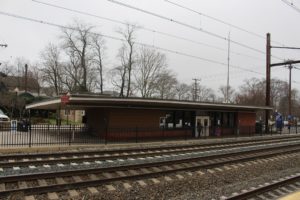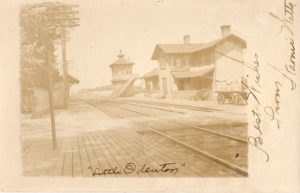History
Odenton’s origins can be traced back more than 170 years to the construction of railroads through a sparsely settled farming community.
In 1840, the steam-powered Annapolis and Elk Ridge Railroad was constructed across in the area we now call Odenton. At the beginning of the Civil War, Union soldiers guarded this railroad because it was the only link between the North and the nation’s capital. Rail traffic through Baltimore had been disrupted by Southern sympathizers, so supplies, mail and soldiers flowed through Annapolis and west Anne Arundel County to Washington.
After the Civil War, Maryland Governor Oden Bowie, who was also president of the Baltimore and Potomac Railroad, built a steam-powered railroad from Baltimore to Washington and Charles County. The junction of the B&P and A&ER bears the name Odenton after Oden Bowie. A station and telegraph office were constructed, and train service began on July 2, 1872. The rail junction (today’s MARC station) at Odenton Road, already a busy thoroughfare from Annapolis to Frederick, became the site of Odenton’s first commercial center. A town grew near the junction.
The Watts and Murray general stores served the railroad workers and farmers, and in 1871 a post office was established. There were new houses built for railroad workers, a Methodist church was dedicated in 1891, and a grade school opened in about 1892.
Shortly after 1900, another company built an electric interurban railroad parallel to the B&P and also electrified the former Annapolis and Elk Ridge Railroad. Train service on these lines began in 1908. The Washington, Baltimore and Annapolis Electric Railroad provided frequent passenger service and stopped at rural communities near Odenton: Severn Run, Gambrills, Waugh Chapel and others. Naval Academy Junction, the point where the two WB&A lines crossed, offered the best public transportation in central Maryland. This junction (today’s Piney Orchard Parkway and Academy Junction Plaza) became the core of new “downtown Odenton” with Taudte’s general store, Murray’s general store, and the Murray Hotel. The WB&A employed many Odenton residents as conductors, motormen, tower operators and shop workers. The car repair shop for the entire WB&A system was located just north of Odenton.
The installation of Camp Meade (now Fort George G. Meade) in 1917 brought new growth to the area and remains a big driver of population and economic growth.
 The WB&A ceased operating in 1935, and routes 170 and 175 were built on part of its right-of-way. Local passenger service continued on the Baltimore and Potomac Railroad, by then part of the Pennsylvania Railroad.
The WB&A ceased operating in 1935, and routes 170 and 175 were built on part of its right-of-way. Local passenger service continued on the Baltimore and Potomac Railroad, by then part of the Pennsylvania Railroad.
In the 1980’s, the State of Maryland expanded and upgraded this service. Today, Odenton is still a railroad town serving commuters and other local passengers. The Dennis F. Sullivan Maintenance Facility, operated by Amtrak and located in Odenton, maintains track, bridges and other structures on the Amtrak/MARC line between Baltimore and Washington.
In 1972, Anne Arundel County identified Odenton as a possible Town Center, with the hopes of channeling new growth to the area. The County Council adopted the Odenton Town Center Growth Management Area plan in 1995, and that plan has been updated and revised a number of times, most recently in 2016.

